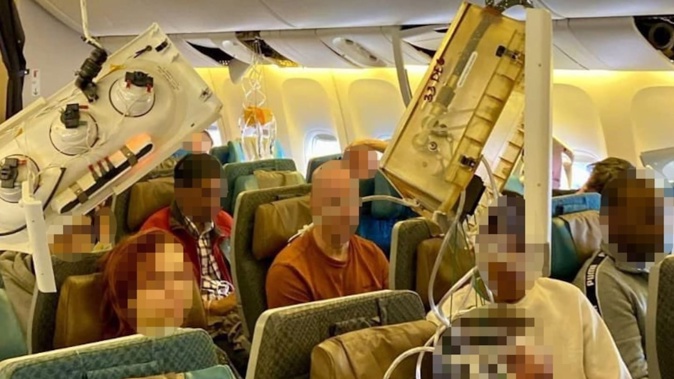
THREE KEY FACTS
- An investigation questions if the Singapore Airlines flight SQ321′s turbulence disaster could have been avoided.
- Ex-Qantas pilot Richard Woodward stated the pilots may have miscalculated storm strength, leading to severe injuries.
- Singapore Airlines has apologised and is discussing compensation with affected passengers, including a woman who was left paralysed from the waist down.
An investigation into one of the worst turbulence disasters has questioned whether the tragedy could have been avoided.
On May 21, Singapore Airlines flight SQ321 hit extreme turbulence while flying from London to Singapore. As the Boeing 777 flew through the storm, 211 passengers were shaken and thrown around the cabin.
One passenger died from a reported heart attack, six experienced brain or skull injuries and one became tetraplegic, paralysed from the waist down.
According to one expert, the disaster could have been avoided, 60 Minutes reported.

A Singapore Airlines Boeing 777-300 at Changi Airport. Photo / Grant Bradley
Richard Woodward, a former Qantas pilot and member of the Australian Air Force with more than 30 years of passenger aircraft experience, told the Australian current affairs programme 60 Minutes it was caused by a “terrible miscalculation”.
On May 21, radar imagery showed other nearby planes diverting to avoid storm activity but SQ321 maintained its planned flight path across Myanmar.
Woodward said the images indicated a large area of thunderstorm activity developing, which the plane consequently was caught up in.
Reports claim the seatbelt sign illuminated approximately eight seconds before the plane experienced its first drop.
“The airplane falls effectively falls 178ft, which puts everyone who’s not strapped in on the roof in the back of the airplane and you pin there while the airplane’s falling,” Woodward said.
“But within a couple of seconds, it goes back to positive G-force and you bang back down to whatever’s below you – seat backs, seats, floor, you name it, whack – it’s all over in 4.6 seconds.”
Woodward said the level of damage in such a short time was “unheard of” and speculated the pilots underestimated the strength of the storm.
“I think in their view, this is benign area and they think they can just over fly it, keep going,” he said.
Initial media reports stated it was caused by “clear air turbulence” but Woodward said the phenomenon does not typically occur in Myanmar.
Singapore Airlines has not explained why the aircraft did not change course, which Woodward called a “profound question”.
“The crew would be seeing all these cells developing on the radar and weighing up whether they need to go around it or not, but it appears from the fact that they’re not deviating, they think they can fit through,” he told 60 Minutes.
“You don’t get to sit in the front of a big airliner unless you’ve done years and years of training, but we don’t know what was going on in the flight deck and we don’t know what they were looking at.”
Singapore Airlines has issued an apology to all passengers on board flight SQ321 and a spokesperson said the airline was fully co-operating with the inquiry being made by the Singapore Transport Safety Investigation Bureau.
The airline said compensation was being discussed with passengers individually. Some reportedly received offers of up to $16,330 the days following the event.
South Australian Kerry Jordan was sitting down after a trip to the bathroom when the flight hit turbulence. Yet to buckle her seatbelt, Jordan was thrown out of her seat and onto the ceiling; her spine broke on impact, leaving her paralysed from the waist down.
Jordan was a dance teacher but now must use a wheelchair to get around and has spent a long period in hospital.
Jordan and her partner, who was also on the flight, claimed Singapore Airlines offered them A$75,000 in compensation.
Take your Radio, Podcasts and Music with you









